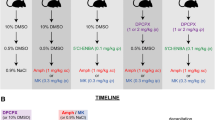Summary
MK-801 [(+)-5-methyl-10,11-dihydroxy-5H-dibenzo-(a,d)cyclo-hepten-5, 10-imine hydrogen maleate], which blocks glutamatergic transmission at the NMDA-receptor-gated ion chanel, induced stereotypies which are similar to those found after intrastriatal injections of AP-5, e.g. sniffing and locomotion. Tests in familiar or unfamiliar environment (non-stressful or stressful situation) did not qualitatively change MK-801-induced effects. Haloperidol (0.1mg/kg, IP) delayed the onset and shortened the duration of MK-801 (0.16; 0.33mg/ kg, IP)-induced stereotypy whereas clozapine (5 mg/kg, SC) potently antagonized it. However, exact quantification of sniffing, measured in an experimental chamber designed for this purpose, revealed an antagonism by both drugs, haloperidol as well as clozapine.
Stereotypy is considered to represent an animal model of schizophrenia, and the antagonism of stereotypy with classical (haloperidol) as well as with atypical (clozapine) antipsychotic drugs is in accordance with the glutamate hypothesis of schizophrenia.
Similar content being viewed by others
References
Beal MF, Kowall NW, Swartz KJ, Ferrante RJ, Martin JB (1988) Systemic approaches to modifying quinolinic acid striatal lesions in rats. J Neurosci 8 (10): 3901–3908
Calderon SF, Sanberg PR, Norman AB (1988) Quinolinic acid lesions of rat striatum abolish D 1- and D 2-dopamine receptor-mediated catalepsy. Brain Res 450: 403–407
Carlsson M, Carlsson A (1989) The NMDA antagonist MK-801 causes marked locomotor stimulation in monoamine-depleted mice. J Neural Transm 75: 221–226
Chiodo LA, Berger TW (1986) Interactions between dopamine and amino acid-induced excitation and inhibition in the striatum. Brain Res 375: 198–203
Clineschmidt BV, Gregory EM, Bunting PR, Papp NL (1982b) Central sympathomimetic activity of (+)-5-Methyl-10,11-dihydro-5H-dibenzo(a,d)cyclohepten-5,10-imine (MK-801), a substance with potent anticonvulsant, central sympathomimetic, and apparent anxiolytic properties. Drug Dev Res 2: 135–145
Cools AR, Peeters BWMM (1987) Behavioral function of neostriatal glutamate and its interaction with dopamine. Neurosci Res Commun 1 (1): 47–55
Keller RW, Stricker EM, Zigmond MJ (1983) Environmental stimuli but not homeostatitc challinges produce apparent increased in dopaminergic activity in the striatum: an analysis by in vivo voltammety. Brain Res 279: 159–170
Kelly PH, Seviour PW, Iversen SD (1975) Amphetamine and apomorphine responses in the rat following 6-OHDA lesions of the nucleus accumbens septi and corpus striatum. Brain Res 507–522
Kim JS, Kornhuber HH, Schmid-Burgk W, Holzmüller B (1980) Low cerebrospinal fluid glutamate in schizophrenic patients and a new hypothesis on schizophrenia. Neurosci Lett 20: 379–382
Koek W, Woods JH, Winger GD (1988) MK-801, a proposed noncompetitive antagonist of excitatory amino acid neurotransmission, produces phencyclidine-like behavioural effects in pigeons, rats and rhesus monkeys. J Pharmacol Exp Ther 245: 969–974
Kornhuber J, Kornhuber ME (1986) Presynaptic dopaminergic modulation of cortical input to the striatum. Life Sci 39: 669–674
Kornhuber J, Mack-Burkhardt F, Kornhuber ME, Riederer P (1989) [3H]MK-801 binding sites in post-mortem human frontal cortex. Eur J Pharmacol 162: 483–490
Kornhuber J, Mack-Burkhardt F, Riederer P, Hebenstreit GF, Reynolds GP, Andrews HB, Beckmann H (1989) [3H]MK-801 binding sites in postmortem brain regions of schizophrenic patients. J Neural Transm 77: 231–236
Nieoullon A, Kerkerian L, Dusticier N (1983) Presynaptic dopaminergic control of high affinity glutamate uptake in the striatum. Neurosci Lett 43: 191–196
Robertson A, MacDonald C (1984) Atypical neuroleptics clozapine and thioridazine enhance amphetamine-induced stereotypy. Pharmacol Biochem Behav 21: 97–101
Sanberg PR (1980) Haloperidol-induced catalepsy is mediated by post-synaptic dopamine receptors. Nature 284: 472–473
Schmidt WJ (1985) Striatal glutamic acid and behaviour. Neurosci Lett [Suppl 22]: 93
Schmidt WJ (1986) Intrastriatal injection of DL-2-amino-5-phosphonovaleric acid (AP-5) induces sniffing stereotypy that is antagonized by haloperidol and clozapine. Psychopharmacology 90: 123–130
Schmidt WJ, Bischoff C (1988) Dopaminergic behavioural responses modulated by NMDA receptor antagonists. Psychopharmacology 96 (1): 51
Schmidt WJ, Bubser M (1989) Anticataleptic effects of N-Methyl-D-Aspartate antagonist MK-801 in rats. Pharmacol Biochem Behav 32: 621–623
Schmidt WJ, Bury D (1988) Behavioural effects of N-Methyl-D-Aspartate in the anterodorsal striatum of the rat. Life Sci 43 (6): 545–549
Snyder SH (1980) Phencyclidine. Nature 285: 355–356
Stahl SM (1988) Sigma, PCP and glutamate sites as a novel target for antipsychotic drugs. Psychopharmacology 96: 28
Weber E (1980) Grundri\ der biologischen Statistik. Fischer, Stuttgart
Author information
Authors and Affiliations
Rights and permissions
About this article
Cite this article
Tiedtke, P.I., Bischoff, C. & Schmidt, W.J. MK-801-induced stereotypy and its antagonism by neuroleptic drugs. J. Neural Transmission 81, 173–182 (1990). https://doi.org/10.1007/BF01245040
Received:
Accepted:
Issue Date:
DOI: https://doi.org/10.1007/BF01245040



